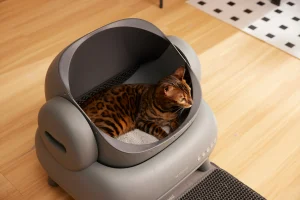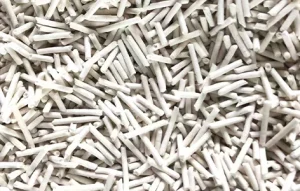Clay vs. Cassava Litter in Tofu-Based Cat Litter Formulations
2025-08-14
Tofu-based cat litters, crafted mostly from soy pulp, are growing popular. Many now mix in cassava litter to make clumping better, control bad smells, and break down naturally. Unlike clay litters, which kick up dust and harm nature, cassava litter soaks up liquid fast, makes little dust, and is kind to the planet, breaking down 92% in just 28 days. Brands like Fat Cat use cassava litter for its safety, green perks, and strong results, making it perfect for homes with many cats or pets with sensitive needs. While clay is still used in some products for solid clumping, plant-based options like cassava litter are now the go-to choice for pet owners who value health and the environment.
Tofu-Based Cat Litter Formulations
Key Ingredients Boosting Performance
Tofu-based cat litter is made from plant stuff, mainly soy pulp or soybean fiber. These soak up liquid well and rot away naturally. But newer mixes add other plant starches to improve clumping and smell control. One top ingredient is cassava litter, which comes from cassava root, also known as tapioca starch. This renewable resource is turned into tiny, super-absorbent bits that are safe for pets and gentle on the earth. Cassava litter steps up how well the litter performs.
Environmental and Health Factors Shaping Choices
Tofu-based litters aim to be safer than old-school clay ones. They skip fake scents, dyes, or harmful chemicals. This makes them great for cats with breathing issues or sensitive skin. Cassava litter comes from renewable cassava plants. It breaks down naturally and creates less trash than clay. Plus, tofu litters with cassava litter meets tough EU green rules, rotting away 92% in 28 days. This earth-friendly choice keeps pets and the planet healthier.

Why Some Litters Still Use Clay
Clay’s Absorbency and Clumping Power
Clay, especially sodium bentonite, is liked because it clumps well. When wet, it forms hard, solid chunks that are easy to scoop. But these chunks are heavy. This makes the litter box tough to lift. Also, they add more trash when tossed out.
Dust from Clay and Its Effect on Breathing
Clay litters have a big flaw: dust. When you pour or scoop, tiny bits float in the air. These can irritate your cat’s lungs or yours, especially if allergies are a problem. On the other hand, cassava litter makes almost no dust. This cuts down on breathing issues for cats and owners, making it a healthier pick.

Clay Mining’s Harm to Nature
Clay mining damages the environment. It uses strip mining, which wrecks habitats and needs lots of energy. Unlike cassava litter, clay doesn’t break down or come from renewable sources. This makes it less friendly to the planet than plant-based options.
How Cassava Litter Performs
Natural Clumping Without Chemicals
Cassava litter clumps well. It forms tight clumps in just 5 seconds when wet. It can soak up 60ml of liquid in only 8 seconds. These clumps stay solid, making scooping easy. This fast clumping locks in moisture quickly. It keeps the litter box clean and simple to manage.
Biodegradability and Compostability
Cassava litter is very biodegradable. Made from 70%–80% cassava starch, it breaks down 92% in 28 days, meeting EU eco-rules. You can flush small amounts, but always check local plumbing rules first. This makes cassava litter a great way to cut down on waste.
Odor Control Without Fake Scents
Cassava litter fights smells naturally. It’s starch neutralizes ammonia and other odors, stopping them from spreading. You get strong smell control without fake scents or harsh chemicals. This keeps your home fresh and safe for your pet.
Comparing Clay and Cassava in Tofu Blends
Handling Moisture
Cassava litter deals with moisture better than clay. It clumps in just 5 seconds when wet, faster than clay, which sometimes forms looser or slower clumps. The quick action of cassava litter traps liquid fast. This keeps the litter box drier and cleaner.
Ease of Cleaning
Cleaning is easier with cassava litter. A thin 2cm layer keeps the litter box bottom clean. You don’t need to change it as often. Unlike clay, which can stick to the box, cassava litter clumps don’t cling. This makes cleanup fast and simple.
Safety If Pets Swallow It
Cassava litter is safer. It’s made from food-grade cassava starch, so it’s low-risk if a pet swallows a bit. This is great for kittens or cats who nibble on litter. Clay, however, isn’t safe to eat. It can cause health issues if ingested.
Fat Cat’s Innovations in Tofu-Based Litter
Cassava’s Role in Fat Cat’s Products
Fat Cat leads the pack by using cassava litterទ6litter in its tofu-based products. The brand focuses on safety, eco-friendliness, and happy customers. Fat Cat’s cassava litter blends food-grade tapioca starch with top-notch dust control for a cleaner home. Its high absorbency and odor control make it ideal for homes with multiple cats. Even people with allergies benefit from its gentle, hypoallergenic formula.
What Users Say About Fat Cat’s Cassava Formula
Pet owners rave about Fat Cat’s cassava litter. They say it clumps fast, doesn’t spread much outside the box, and keeps odors away without fake scents. The dust rate is very low—less than 0.13%—better than clay litters like bentonite. This makes it a clean, easy choice for busy homes.
Why Fat Cat Skips Clay
Clay doesn’t match Fat Cat’s mission. The brand cares about the environment and pet safety, especially for cats with sensitivities. Clay creates dust and harms nature. So, Fat Cat chooses plant-based cassava litter for great performance while staying green and safe.
If you want a trusted brand that balances quality and planet care, try Fat Cat’s premium cassava litter.
Choosing the Best Formula for You
Why Pick Cassava-Enhanced Tofu Litter
Choose cassava litter if you have multiple cats or a pet with sensitivities. Its low dust and non-toxic nature make it perfect for homes with allergy-prone cats or people. It’s great for busy households needing safe, easy litter. Best for: Multi-cat homes, sensitive cats, allergy sufferers.
Sustainability Perks for Green-Minded Owners
Cassava litter is the greenest option. It comes from plants, breaks down fast, and cuts landfill waste through composting or flushing (in small amounts). If you care about the earth, cassava litter supports a cleaner, greener future.
When Clay Blends Might Help
Clay blends can be useful for extra-strong clumping, like during long trips when scooping isn’t possible daily. But clay isn’t as eco-friendly or safe for sensitive pets. For most homes, cassava litter beats clay in almost every way.
The Future of Eco-Friendly Cat Litter
Moving to Plant-Based Ingredients Like Cassava
People are learning more about pet health and nature. This pushes brands to use biodegradable materials like cassava litter instead of mined clay or silica crystals. Compared to clay, cassava litter has no dust, better odor control, and is kinder to the planet. As pet owners demand greener products, plant-based litters are becoming standard.
Fat Cat’s Leadership in Green Innovation
Fat Cat keeps pushing forward with research-driven formulas. They focus on safe, high-performing products, like cassava litter with zero formaldehyde testing. By setting high standards for safety and sustainability, Fat Cat inspires others to follow. Eco-friendly pet care is becoming the future, not just a choice.
FAQ
Q1: Can I flush cassava litter down the toilet?
A: Yes, but only a little at a time. Small clumps can be flushed. Always check local plumbing rules first.
Q2: Does cassava litter attract bugs?
A: No, it resists pests when kept dry, thanks to its natural starch makeup.
Q3: How often should I replace cassava litter?
A: Scoop daily. Change it fully every 4–6 weeks, depending on your cat’s use.


